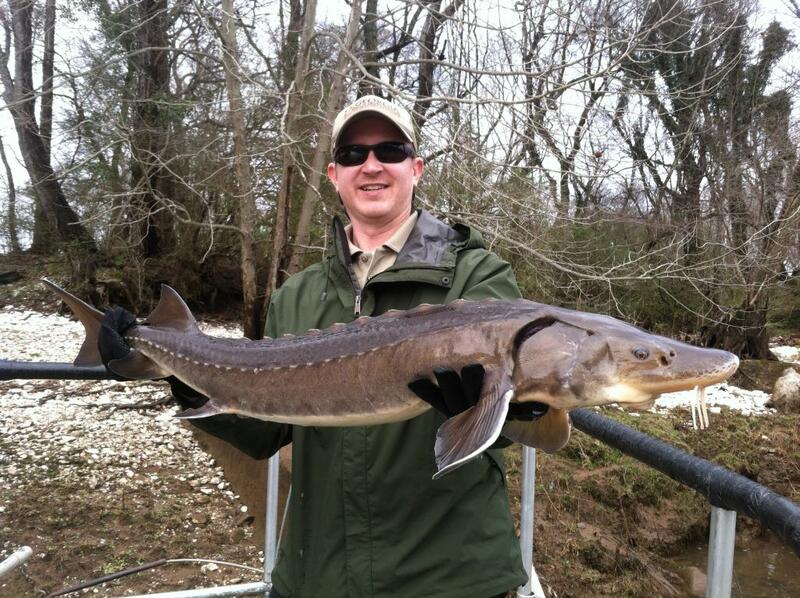







Loading profile. Please wait . . .
Acipenser fulvescens Rafinesque, 1817
Lake Sturgeon





Federal Protection: No US federal protection
State Protection: No Georgia state protection
Global Rank: G3G4
State Rank: S3
Element Locations Tracked in Biotics: Yes
SWAP 2015 Species of Greatest Conservation Need (SGCN): Yes
SWAP 2025 Species of Greatest Conservation Need (SGCN): Yes
2025 SGCN Priority Tier: Moderate Conservation Concern
Element Occurrences (EOs) in Georgia: 16
Habitat Summary for element in Georgia: Large freshwater rivers and lakes over clean firm substrates
Lake Sturgeon belong to the family Acipenseridae, which is considered an ancient and relatively primitive group. Their skeletons are mostly cartilaginous, with a few bones present in the head. Like other sturgeons, Lake Sturgeon have bony plates along the body (scutes), an asymmetrical tail, barbels (colloquially known as whiskers) and a small, ventral, toothless mouth that protrudes while feeding. Coloration is usually dark brown or grey, but in very turbid water individuals may be a lighter shade of tan. Most sturgeon species are anadromous, living primarily in salt water and seasonally moving to freshwater to reproduce. In contrast, Lake Sturgeon spend their entire lives in freshwater, migrating further upstream to spawn. They are long-lived (sometimes over 100 years) and can weigh over 100 pounds.
All Lake Sturgeon in Georgia are from stocking efforts through the Lake Sturgeon Reintroduction Program.
Lake Sturgeon are the only sturgeon species found in the upper Coosa River basin. No similar fish occur in the Coosa River system in Georgia.
Lake Sturgeon inhabit large lakes and deep rivers with a variety of substrates. Foraging typically occurs over mud, sand, and gravel where preferred prey can be found. Adults often migrate long distances (up to 200 km) upstream to spawn over clean rocky substrates.
Sturgeon feed primarily on benthic organisms like crayfishes, mollusks, worms, and insect larvae. They are also opportunistic, and will eat dead fish or other food items as presented.
Lake sturgeon are very long-lived and slow to mature. Males take 12 – 15 years to reach sexual maturity, while females may not mature until 15 – 25 years of age. After maturity, individuals may not spawn annually, with females spawning every 4 – 6 years and males spawning every year or in alternating years. Spawning adults gather in groups over cobble and boulder substrates in shallow areas with moderate current. Spawning occurs in springtime at water temperatures between 12 – 16 C. Eggs are adhesive, and hatch after about a week of incubation. Young sturgeon migrate downstream out of the smaller spawning tributaries to the main river where they grow to adulthood.
GADNR Wildlife Resources Division monitors the Coosa River Lake Sturgeon population using various gear types, including gill and trammel nets, trotlines, and electrofishing. Data collected via these methods are critical to monitoring efforts and should continue. The public can also help our monitoring efforts by reporting incidental catches and sightings to the the Armuchee Fisheries Office at 706-295-6102. Please include location information and report any photographs taken. Any Lake Sturgeon caught must be released unharmed immediately.
The native range of Lake Sturgeon includes the Great Lakes and Hudson Bay drainages, along with much of the upper and middle Mississippi River basin. Historical accounts and photographs also indicate the species was native to the Coosa River basin in northwest Georgia and northeast Alabama. Records indicate the Coosa River population was extirpated by around 1970. WRD has been working to restore the species to its native range in Georgia since 2002. Fingerlings raised from Great Lakes sources have been stocked annually, and adults from these stockings are now maturing and making spawning runs into Coosa River tributary rivers.
Lake Sturgeon were formerly plentiful across their native range prior to 1860, and were even considered a nuisance bycatch in some locations. Limited reproduction potential coupled with over-harvest, water pollution and obstruction of migration by dams all were likely factors contributing to the extirpation of the original Coosa population. Major dams still impact migration today, but water quality is vastly improved, and no harvest of Lake Sturgeon is currently allowed by law.
| Threat 1 | Threat 2 | Threat 3 | |
|---|---|---|---|
| General Threat | Natural system modifications | Pollution | Climate change & severe weather |
| Specific Threat | Dams & water management/use | None | None |
All Lake Sturgeon in Georgia are from stocking efforts through the Lake Sturgeon Reintroduction Program. Stocked Lake Sturgeon are surviving, growing, and maturing in the Coosa River and its main tributaries. Mature individuals of both sexes up to 20 pounds have been collected recently on potential spawning grounds, and actively spawning fish were reported from one such location in Spring 2022. Data collected by WRD and our partners suggests a small but healthy population has become established, and that recovery is well-underway. However, successful natural recruitment has yet to be documented, so fingerling stocking remains important and must continue until the species can sustain itself naturally.
Attention must be given to conserving potential Lake Sturgeon spawning areas on major Coosa River tributaries. Managers must ensure open migration routes from Lake Weiss upstream to these spawning areas, and continue to increase population size and potential spawning stock through fingerling stocking.
https://georgiawildlife.com/lake-sturgeon-reintroduction-program
Boschung, H. and R. Mayden. 2004. Fishes of Alabama. Smithsonian Books, Washington. 736 pp.
Beisser, G.S. 2009. The Lake Sturgeon, Acipenser fulvescens, Restoration Program in Georgia. 27 pp.
John Damer, Deb Weiler
12/20/2022